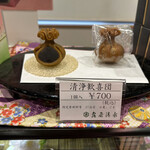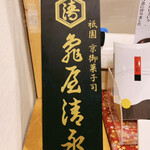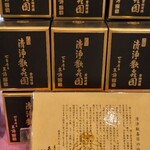
亀屋清永 三十三間堂店
Kameyakiyonaga ◆ 三十三间堂
3.05
Gion, Kiyomizu-dera, Higashiyama
「Japanese Sweets」
--
--
京都府京都市東山区三十三間堂廻り657 三十三間堂内
Photos
(12)












Details
Payment Method
No credit cards
Electronic money is not accepted
Private Dining Rooms
None
Parking
having
Comments
(6)
☆AKIKO☆
3.50
After visiting the main hall of Sanjusangendo, I couldn't resist checking out the Kyoto sweets corner. They were sold out of the popular souvenir senbei that I was eyeing, so I was looking for something else to buy. Since I like dried sweets, I was considering buying some, but the shopkeeper recommended a sweet called "Seijokanki" to me. They said it's a traditional sweet that has been around for a thousand years, with sweet bean paste inside a hard fried pastry. It cost 700 yen per piece. It was a bit pricey, but I thought of it as a donation as well. Maintaining a magnificent temple like Sanjusangendo must require a lot of money. When I opened the box back at the hotel, I was excited to try it, but it turned out to be... not very tasty. It was oily and hard, like eating incense. It said on the box that it contains 7 types of incense. Once was enough, I think.




@わに
3.50
We thoroughly enjoyed Sanjusangendo and at the souvenir shop near the exit, my wife bought the "Tsukikage" hand-sized yokan, which we enjoyed eating. The alligator quickly moved on to the next shop with a rating of 3.05 stars from 4 people. 🐊🎶




美味B級
3.40
After the second half of Golden Week, I went sightseeing in Kyoto. After visiting Toji Temple, I went to Sanjusangendo. After admiring the impressive thousand Buddha statues, I purchased some wagashi (Japanese sweets) at the temple's shop. When I got home, I enjoyed them with green tea.
- Tsukigane (¥170 including tax): A wagashi made with black sugar and walnuts. It is said to be made with the desire to create a sweet that is loved by everyone, just like the moonlight that shines on everyone equally. The slightly sweet yokan with the flavor of walnuts is a good accent. Rating: ★3.5
- Kurikuri (¥150): A bite-sized round peach-shaped baked wagashi filled with chestnut paste. It has a moderate sweetness, elegant crispy skin, and maybe some mustard seeds on top. Rating: ★3.4
Both are delicious, but they are a bit small for the price. Bon appétit!




グルメ放浪記
3.30
It seems that it is a shop with a history dating back to 1617, as stated on the shop's website. It is a traditional Japanese confectionery shop located inside the Sanjusangendo Temple, which adds to its credibility. Passing by, I was approached by a staff member who proudly claimed, "This is the oldest confectionery in Japan. It is made using the same traditional methods from the past. Would you like to try it?" Being a tourist, I couldn't resist and decided to try it out. After feeling the history at Sanjusangendo, the idea of trying Japan's oldest confectionery intrigued me. I thought of buying a few as souvenirs, but they were around 600 yen each...for just one piece. However, each piece came in a grand box, which added to the atmosphere. When I got home, I tried the confectionery. It was hard, really hard. It felt like I was chewing on incense and wasn't very sweet. Reading the description, I found out that it contained incense. It was a unique and valuable experience trying this confectionery. In Kyoto, you can feel the history at Sanjusangendo and then continue to experience it with the souvenir you bought there. It's a wonderful shop and confectionery that is worth trying at least once, even if it may not be the most delicious. Of course, the main shop offers a variety of delicious modern Japanese confectioneries.



モリ食べログ
3.50
- Kameya Kinen Garden ¥650 ★★★★ ※Incense is kneaded into the sweet bean paste. (2021.08.27.)
[From the product description]
Kameya Kinen Garden (seijou kanki dan) is a type of Tang Dynasty confectionery called "Danki" that has been passed down since the Nara period. It is often referred to as "Odango." Among the many Kyoto confectioneries, this sweet has been preserved in its original form from a thousand years ago and is an essential part of the history of Japanese sweets. Kameya Kinen is the only Japanese confectionery that produces this sweet. The sweet bean paste kneaded with seven types of incense symbolizing purification is wrapped in a dough made of rice flour and wheat flour, shaped like a gold bag, closed with eight knots representing lotus leaves, and fried in high-quality sesame oil. It is said that in ancient times, nuts such as chestnuts, persimmons, and apricots were seasoned with medicinal herbs like kanzo and amazura, and the use of sweet bean paste began in the latter part of the Edo period. Kameya Kinen learned the secret method from an Ajari on Mt. Hiei and has been preparing it around the first and fifteenth day of the month, following strict purification practices.
- Other Information
* No dining space (only sales).
* No complimentary water.
* No complimentary towels.
* Restrooms are located in an external facility (Sanjusangendo).
* No charging facilities (no power outlets).
* Customer service is normal.
* Cleaning and setting up are normal.
* Customers are required to remove their shoes.
* The crowd level may vary depending on the season and time, but there was no waiting to enter or pay at the register.
* The main store is located within Sanjusangendo and requires an additional admission fee (¥600), adding to its exclusivity. (2021.08.27.)
[From the store introduction]
Kameya Kinen was founded in the third year of the Genwa era (1617) and was originally located at Teramachi Sanjo Kita-iri. The store was initially named Kameya Yahei, but later changed to Kameya Kinen. In the fourth year of Ansei (1857), the Edo shogunate, following the customs and practices of the Imperial Court, restricted the upper confectioners who created Kyoto confectioneries based on courtly traditions such as waka poetry and haikai. Only 28 confectioners were allowed to serve as "Imperial Confectioners," leading to an increased recognition of Kyoto as the home of confectionery, with Kameya Kinen being one of the select few known as the "Kyogashi-shi" or Kyoto confectioner.




TenG
3.00
Autumn in Kyoto is elegant. The glimpses of autumn leaves and ancient temple scenery are truly charming. The Sanjusangendo Temple is famous for its long hall with 33 bays, and inside there are over a thousand statues, each said to have a face resembling someone. I wanted to find my look-alike statue but couldn't (laughs). It would be nice if there were a service to help find a similar statue. After the tour, I visited the shop area, where I found this branch store. (It's written on the receipt, so no mistake.) The main store has celebrated its 400th anniversary, a testament to the ancient city of Kyoto.
- Seijokankidan (600 yen): When the salesperson called it the "oldest confectionery," I was intrigued to buy it. It is a type of Tang dynasty confectionery that has been passed down since the Nara period, preserving its original form for over a thousand years. It seems that only Kameya Seiei can produce it. It's hard, so you need to warm it up before eating... and it has sweet bean paste inside, with a unique taste. If you want to experience the history of the oldest confectionery in a place like this, give it a try!




Email Login